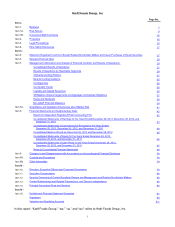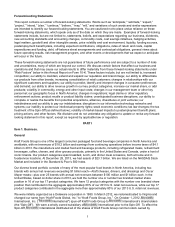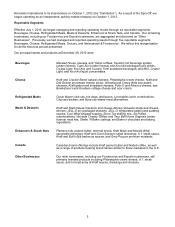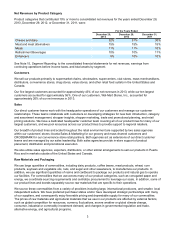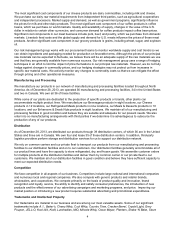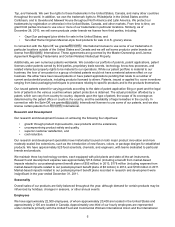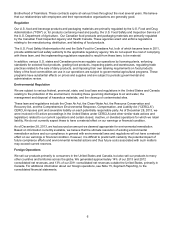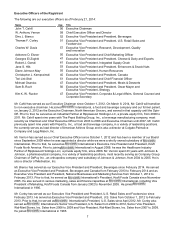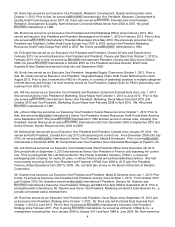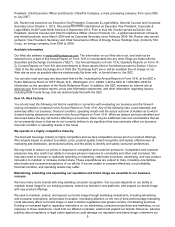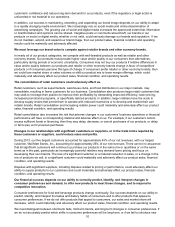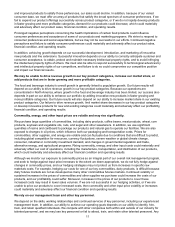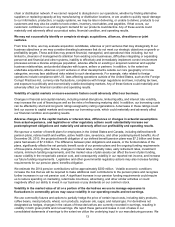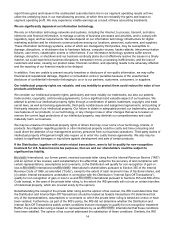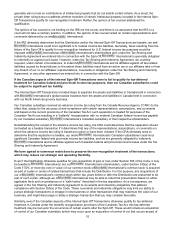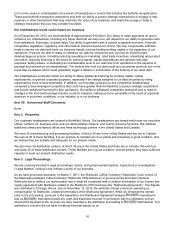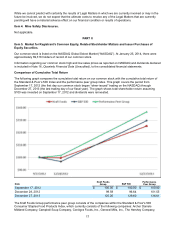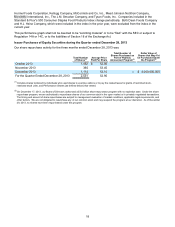Kraft 2013 Annual Report Download - page 12
Download and view the complete annual report
Please find page 12 of the 2013 Kraft annual report below. You can navigate through the pages in the report by either clicking on the pages listed below, or by using the keyword search tool below to find specific information within the annual report.10
customers’ confidence and reduce long-term demand for our products, even if the regulatory or legal action is
unfounded or not material to our operations.
In addition, our success in maintaining, extending, and expanding our brand image depends on our ability to adapt
to a rapidly changing media environment. We increasingly rely on social media and online dissemination of
advertising campaigns. The growing use of social and digital media increases the speed and extent that information
or misinformation and opinions can be shared. Negative posts or comments about Kraft, our brands or our
products on social or digital media, whether or not valid, could seriously damage our brands and reputation. If we
do not maintain, extend, and expand our brand image, then our product sales, financial condition and operating
results could be materially and adversely affected.
We must leverage our brand value to compete against retailer brands and other economy brands.
In nearly all of our product categories, we compete with well-branded products as well as retailer and other
economy brands. Our products must provide higher value and/or quality to our consumers than alternatives,
particularly during periods of economic uncertainty. Consumers may not buy our products if relative differences in
value and/or quality between our products and retailer or other economy brands change in favor of competitors’
products or if consumers perceive this type of change. If consumers prefer retailer or other economy brands, then
we could lose market share or sales volumes or shift our product mix to lower margin offerings, which could
materially and adversely affect our product sales, financial condition, and operating results.
The consolidation of retail customers could adversely affect us.
Retail customers, such as supermarkets, warehouse clubs, and food distributors in our major markets, may
consolidate, resulting in fewer customers for our business. Consolidation also produces larger retail customers that
may seek to leverage their position to improve their profitability by demanding improved efficiency, lower pricing,
increased promotional programs, or specifically tailored products. In addition, larger retailers have the scale to
develop supply chains that permit them to operate with reduced inventories or to develop and market their own
retailer brands. Retail consolidation and increasing retailer power could materially and adversely affect our product
sales, financial condition, and operating results.
Retail consolidation also increases the risk that adverse changes in our customers’ business operations or financial
performance will have a corresponding material and adverse effect on us. For example, if our customers cannot
access sufficient funds or financing, then they may delay, decrease, or cancel purchases of our products, or delay
or fail to pay us for previous purchases.
Changes in our relationships with significant customers or suppliers, or in the trade terms required by
these customers or suppliers, could reduce sales and profits.
During 2013, our five largest customers accounted for approximately 43% of our net revenues, with our largest
customer, Wal-Mart Stores, Inc., accounting for approximately 26% of our net revenues. There can be no assurance
that all significant customers will continue to purchase our products in the same mix or quantities or on the same
terms as in the past, particularly as increasingly powerful retailers may demand lower pricing and focus on
developing their own brands. The loss of a significant customer or a material reduction in sales, or a change in the
mix of products we sell, to a significant customer could materially and adversely affect our product sales, financial
condition, and operating results.
Disputes with significant suppliers, including disputes related to pricing or performance, could adversely affect our
ability to supply products to our customers and could materially and adversely affect our product sales, financial
condition, and operating results.
Our financial success depends on our ability to correctly predict, identify, and interpret changes in
consumer preferences and demand, to offer new products to meet those changes, and to respond to
competitive innovation.
Consumer preferences for food and beverage products change continually. Our success depends on our ability to
predict, identify, and interpret the tastes and dietary habits of consumers and to offer products that appeal to
consumer preferences. If we do not offer products that appeal to consumers, our sales and market share will
decrease, which could materially and adversely affect our product sales, financial condition, and operating results.
We must distinguish between short-term fads, mid-term trends, and long-term changes in consumer preferences. If
we do not accurately predict which shifts in consumer preferences will be long-term, or if we fail to introduce new


